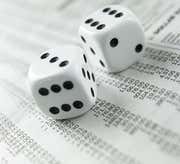
|
Now that we’ve calculated ACME Corp.’s free cash flow over the next five years, it’s time to figure out what the cash flows are worth today. To do that, we need an appropriate discount rate, which we’ll use to calculate the net present value (NPV) of the cash flows.
Weighted Average Cost of Capital - WACC
There are a number of methods that can be used to determine discount rates. A good approach – and the one we’ll use in this tutorial – is to use the weighted average cost of capital (WACC) – a blend of the cost of equity and after-tax cost of debt.
A company has two primary sources of financing – debt and equity – and, in simple terms, WACC is the average cost of raising that money. WACC is calculated by multiplying the cost of each capital source (debt and equity) by its relevant weight, and then adding the products together to determine the WACC value:

Where:
Re = cost of equity
Rd = cost of debt
E = market value of the firm’s equity
D = market value of the firm’s debt
V = E + D
E/V = percentage of financing that is equity
D/V = percentage of financing that is debt
Tc = corporate tax rate
When calculating a firm's WACC, the first step is to determine what proportion of a firm is financed by equity and what proportion is financed by debt by entering the appropriate values into the and components of the equation. Next, the proportion of equity () is multiplied by the cost of equity (Re); and the proportion of debt ( ) is multiplied by the cost of debt (Rd).
The debt side of the equation ( * Rd) is then multiplied by (1 - Tc) to get the after-tax cost of debt (there is a tax shield associated with interest). The final step is to add the equity side of the equation to the debt side of the equation to determine WACC.
To calculate WACC for ACME Corp., we’ll assume the following financials:
Equity = $80M
Debt = $20M
Re = 12.5%
Rd = 6%
Tax rate = 30%
To find WACC, we’ll enter the values into the equation and solve:

The WACC for ACME Corp., then, is 10.84%, and we’ll go ahead and round up to 11%.
Keep in mind: Because the WACC calculation takes a long time, many investors prefer to use online stock analysis tools to find the number.
Next, we’ll calculate a fair value for ACME Corp.
DCF Analysis: Coming Up with a Fair Value
-
 Investing
InvestingInvestors Need A Good WACC
Weighted average cost of capital may be hard to calculate, but it's a solid way to measure investment quality. -
 Personal Finance
Personal FinanceWhat to know for an investment banking interview
Find out what you need to know and how to prepare for an investment banking interview. -
 Managing Wealth
Managing WealthWeighted Average Cost Of Capital (WACC)
Weighted average cost of capital may be hard to calculate, but it's a solid way to measure investment quality -
 Small Business
Small BusinessExplaining Cost Of Capital
Cost of capital is the cost of funds used to finance a business. -
 Investing
InvestingDCF Valuation: The Stock Market Sanity Check
Calculate whether the market is paying too much for a particular stock. -
 Investing
InvestingDiscounted Cash Flow Analysis
Find out how analysts determine the fair value of a company with this step-by-step tutorial and learn how to evaluate an investment's attractiveness for yourself. -
 Investing
InvestingTop 3 Pitfalls Of Discounted Cash Flow Analysis
Find out why the Discounted Cash Flow (DCF) method can be difficult to apply to real-life valuations.


